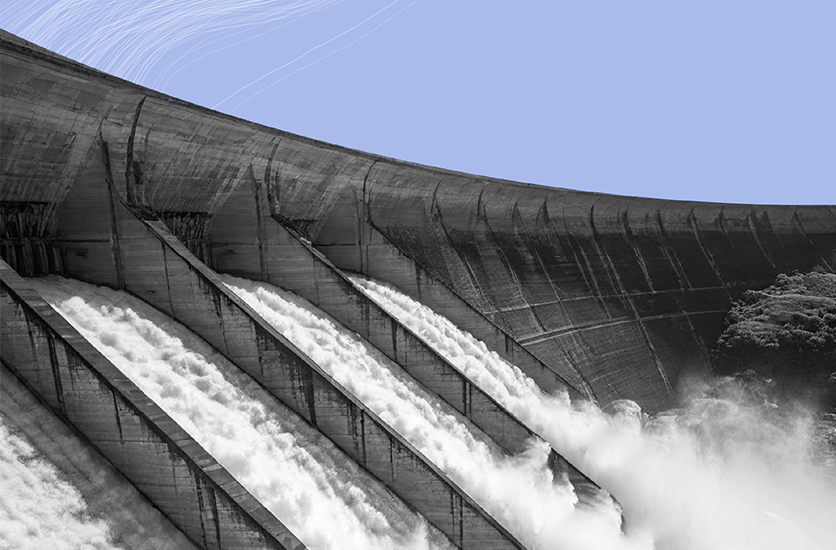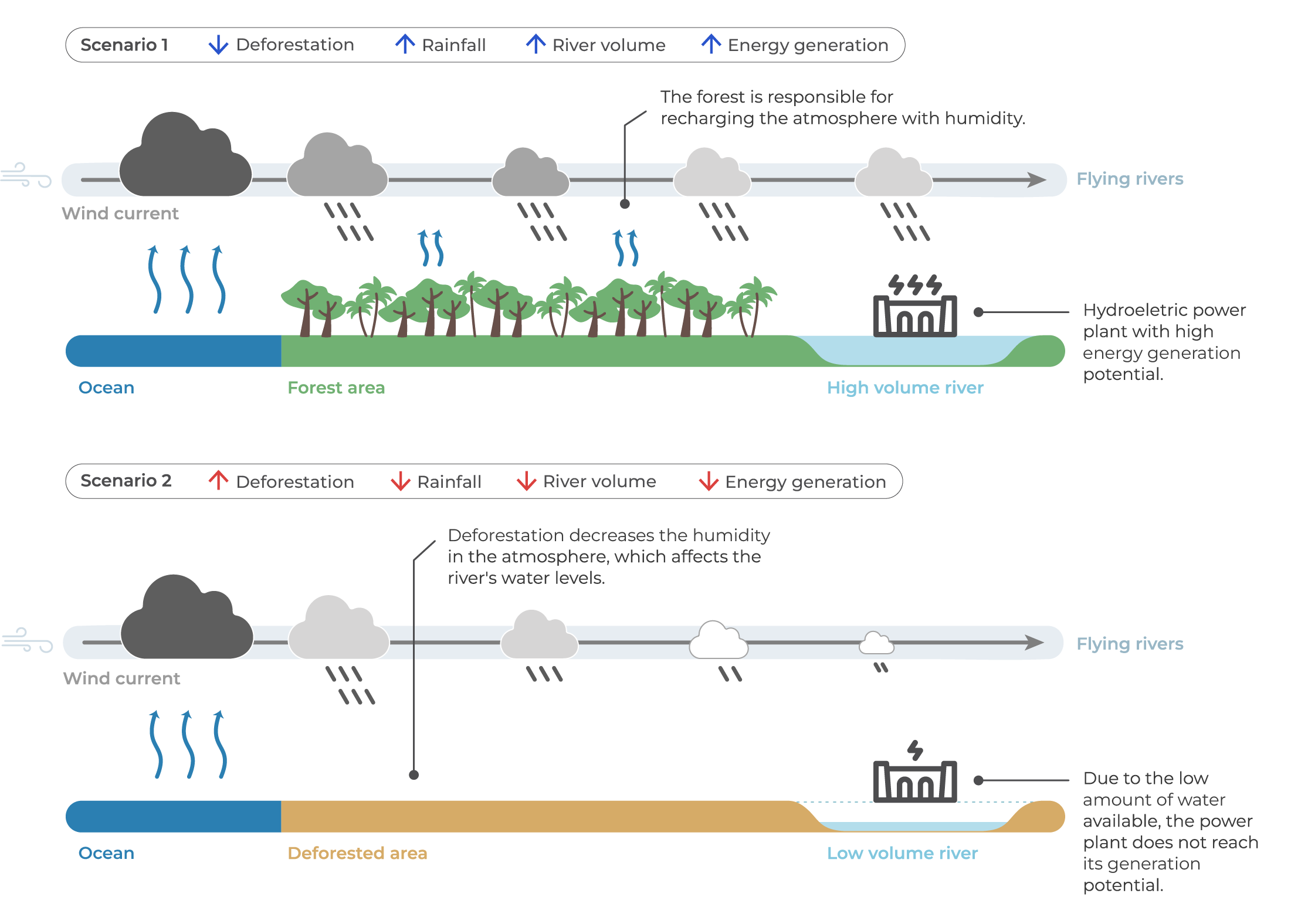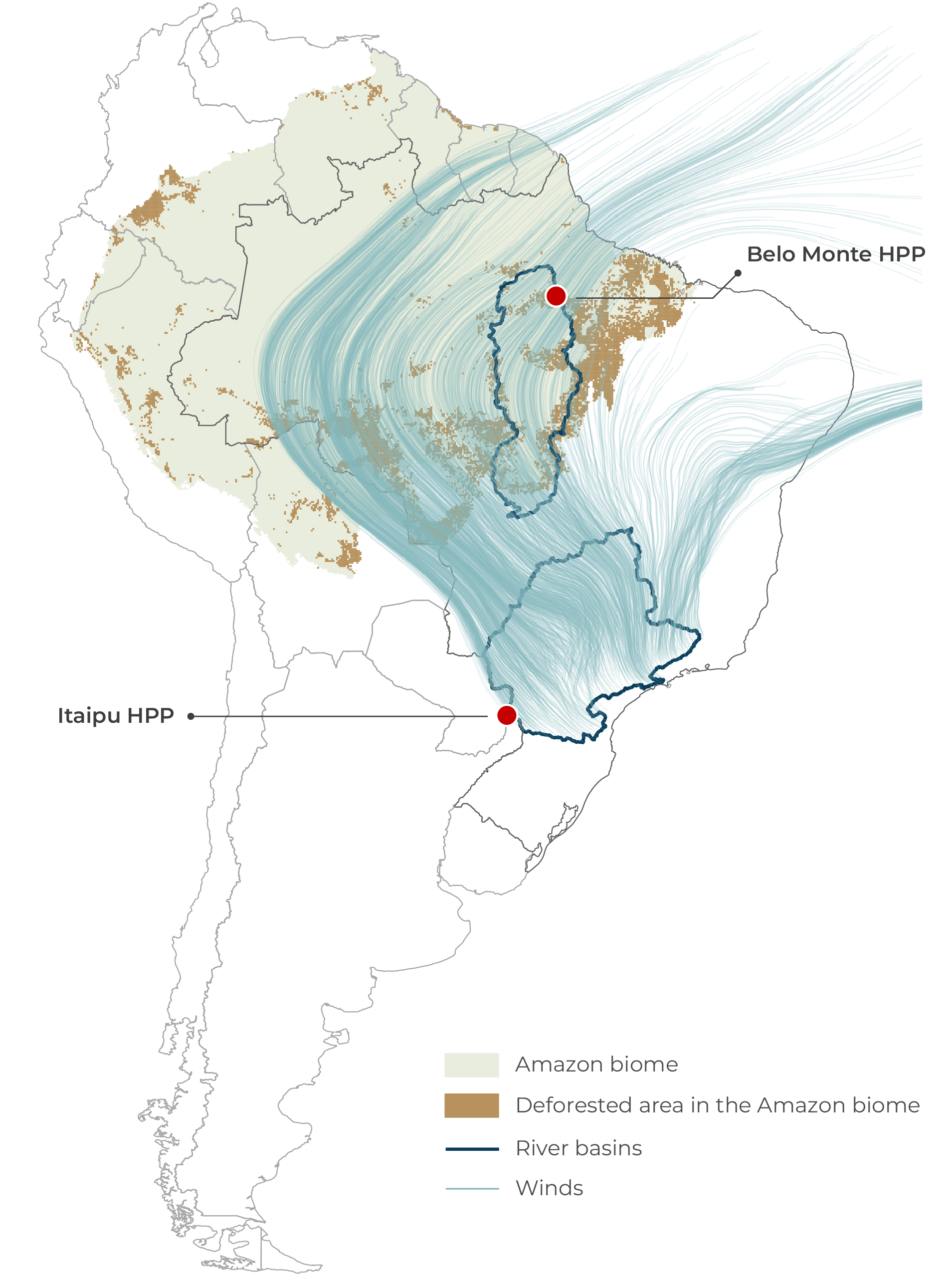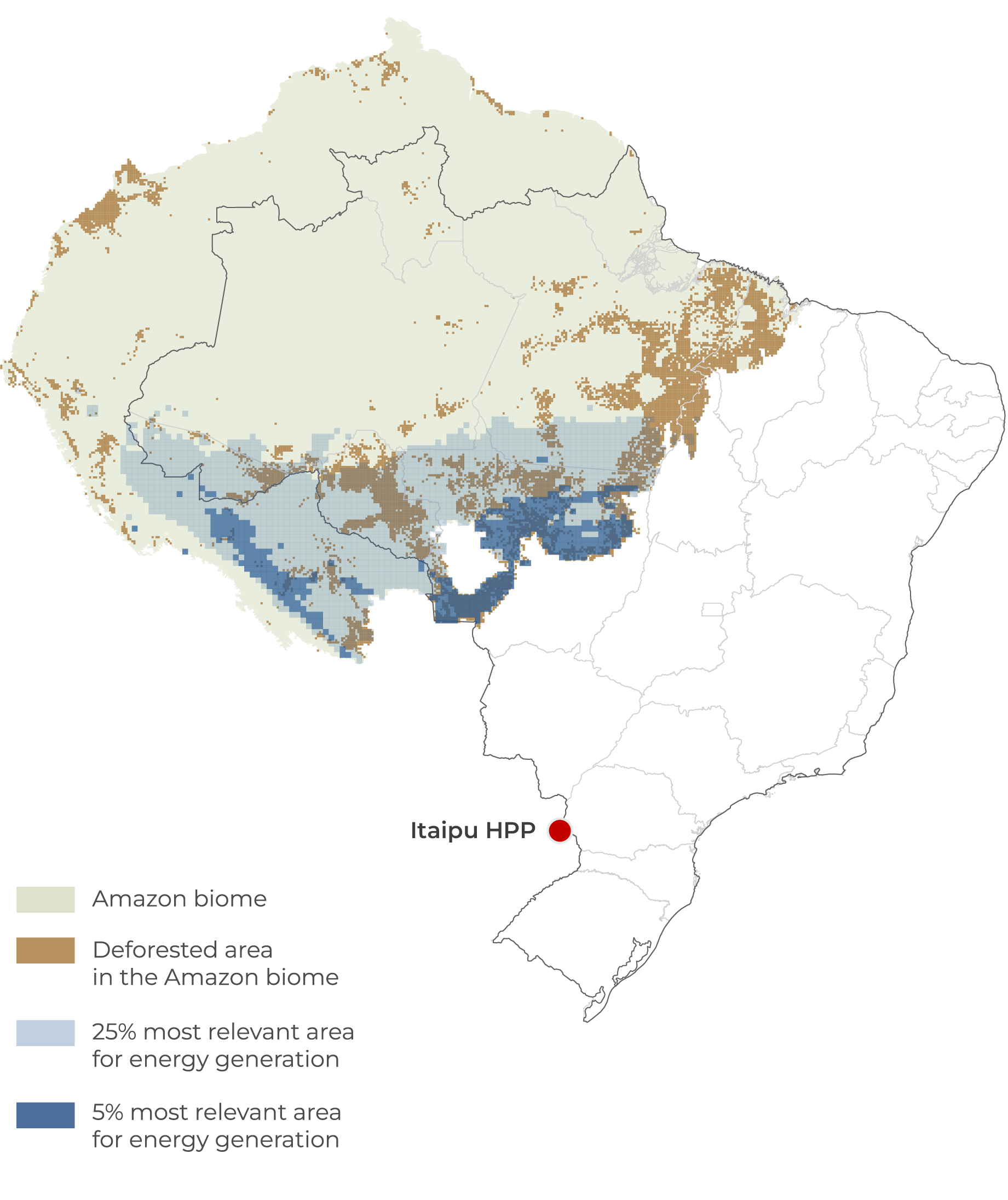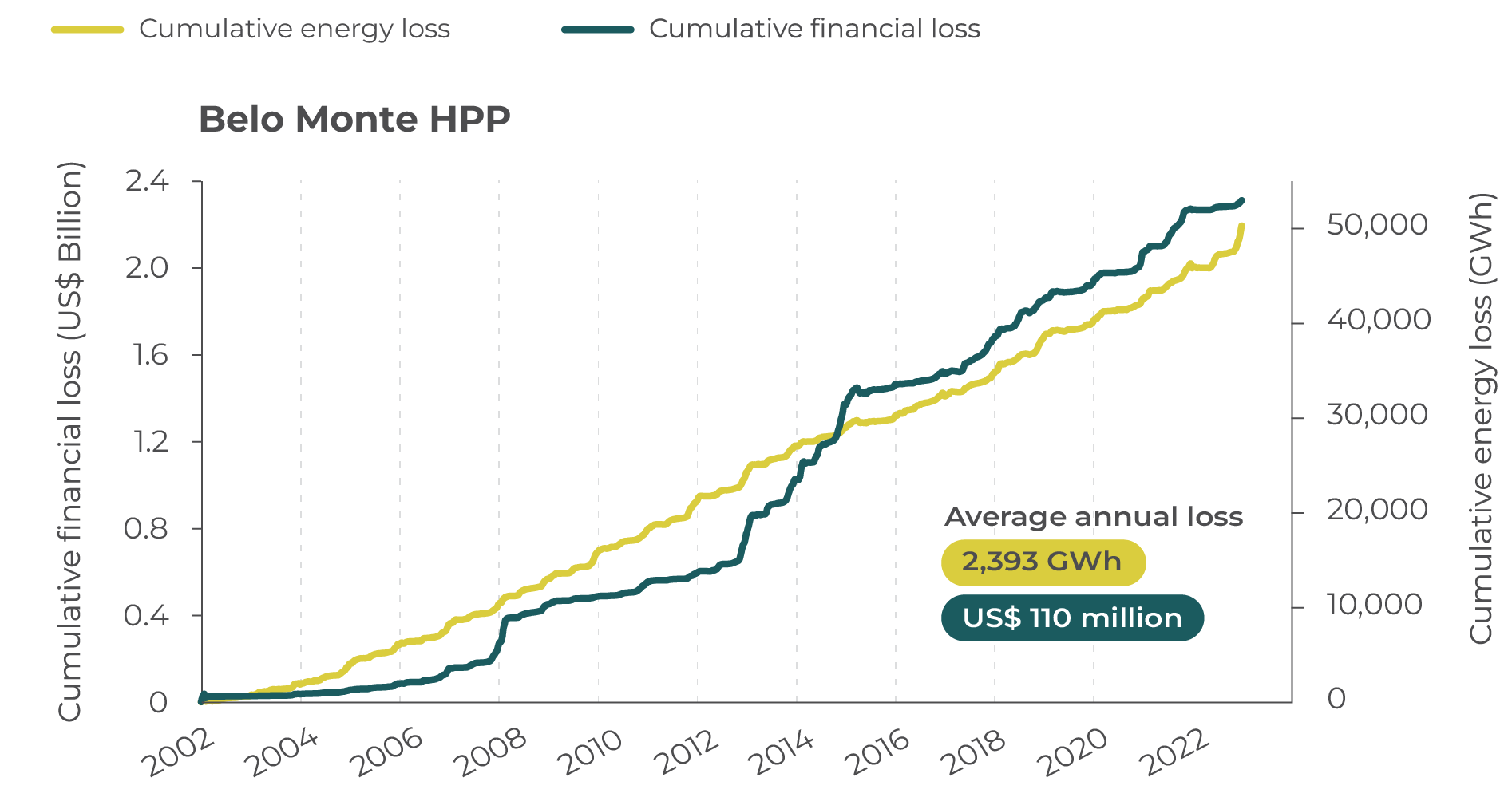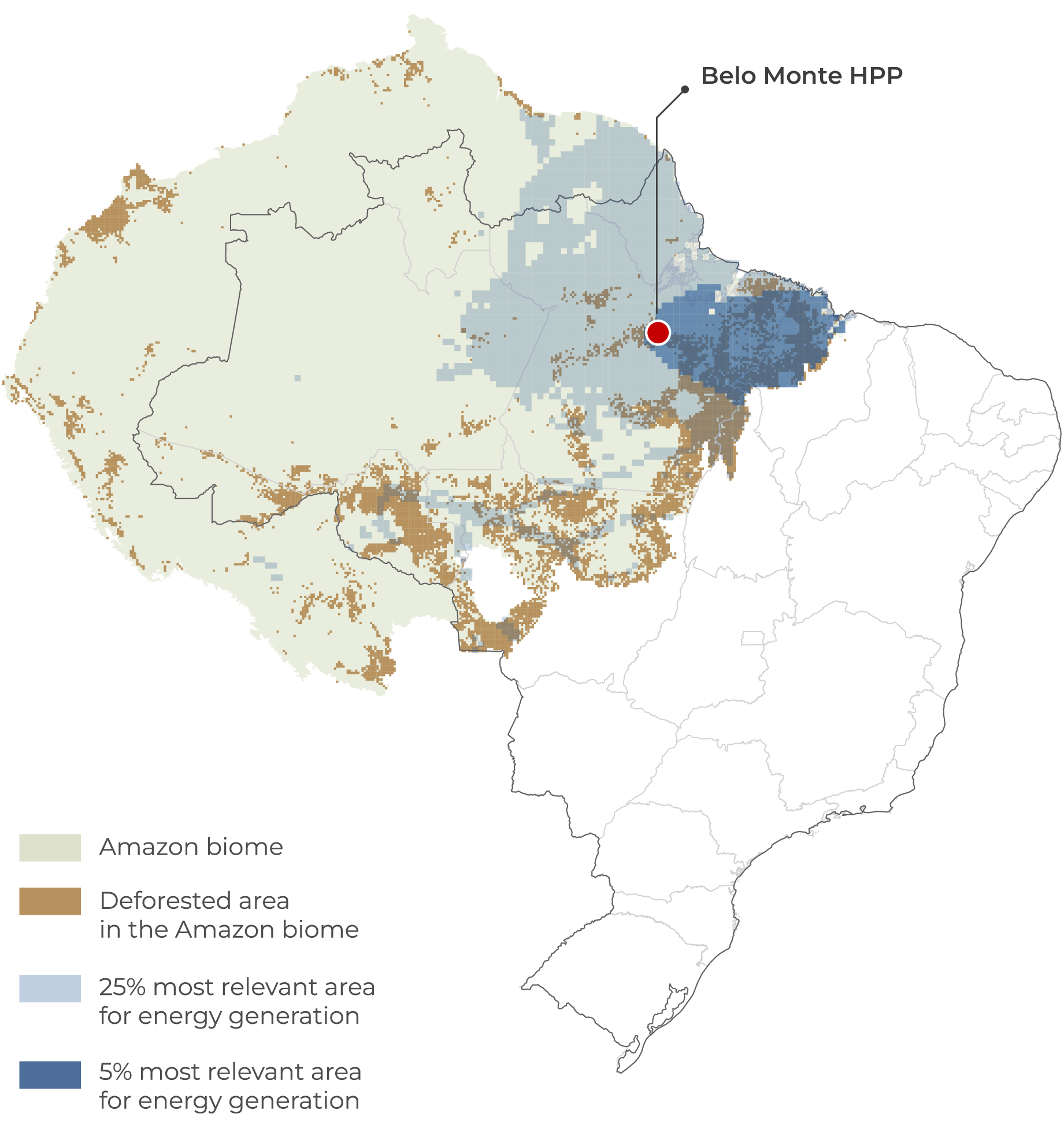Select language
Trends
Global Climate Reports
| Title |
[기타] Deforestation Cuts the Lights: Itaipu, Belo Monte, and the Cost of Forest Loss |
|---|---|
| Category | |
|
IntroductionBrazil’s two largest hydroelectric power plants (HPPs), Itaipu and Belo Monte, play essential roles in the country’s electricity sector. With respective installed capacities of 14 GW and 11.2 GW, they account for around 11% of Brazil’s electricity generation capacity. However, full realization of the plants’ potential depends on water availability in the rivers on which they are located. Deforestation of the Amazon forest modifies rainfall in hydrographic basins both inside and outside this biome, reducing the flow of rivers and negatively affecting the HPPs’ power generation. Researchers from the Climate Policy Initiative/Pontifical Catholic University of Rio de Janeiro (CPI/PUC-RIO) and Amazon 2030 have analyzed the impact of changes in rainfall patterns caused by deforestation on the electricity generation—and associated revenues—of the Itaipu and Belo Monte HPPs. This analysis has identified that, together, the HPPs are losing 3,780 GWh in energy generation potential per year due to deforestation. This is equivalent to the electricity consumption of approximately 1.5 million people and around US$ 200 million in revenue for the HPPs. Hydropower has historically been Brazil’s primary source of electricity, accounting for 48.6% of the country’s installed capacity and 60.2% of total generation in 2023.[1] This publication explores two case studies to show how changes in hydrological regimes as a result of Amazon deforestation have exposed the vulnerability of Brazil’s two largest HPPs, testing the resilience of the country’s overall electricity mix. Each case evaluates the effects of Amazon deforestation on the respective plants. Itaipu, the country’s largest HPP, is located on the border between the Brazilian state of Paraná and Paraguay, more than 1,000 kilometers outside the Amazon biome. The plant represents 6% of Brazil’s electricity mix and generated equivalent to 15.7% of the country’s total energy consumption in 2023.[2] In 2023, Itaipu HPP’s average loss of annual electricity generation potential induced by deforestation is estimated at 1,380 GWh. This translates into a loss of approximately US$ 86 million in revenue per year, approximately 6% of the plant’s recent annual average profit. The second case study conducts the same analysis for Belo Monte HPP, Brazil’s second-largest HPP, located in the state of Pará, within the Amazon biome. The plant accounts for 5% of the national electricity mix, supplying 5.9% of all energy used in the country in 2023.[3] The average loss of annual electricity generation potential due to deforestation is estimated at 2,400 GWh. This translates to an annual loss of US$ 110 million in revenue—approximately 20% of the plant’s earnings before interest, taxes, depreciation, and amortization (EBITDA). The report also identifies the areas of the Amazon that influence the electricity generation of the Itaipu and Belo Monte plants. The area affecting Belo Monte HPP is more concentrated than that affecting Itaipu HPP, which is influenced by air currents with trajectories that extend over several regions of Brazil. Identifying the areas that most affect energy generation can guide better implementation of conservation and restoration policies, allowing the appropriate targeting of resources to mitigate the adverse effects for the energy sector. The results show that Brazil’s largest HPPs are already being affected by Amazon deforestation. This creates a strategic necessity for the electricity sector to actively participate in the country’s environmental agenda. Greater definition and integration of strategies that reconcile forest conservation and restoration policies with those for electricity generation are crucial for the security of the electricity sector and for boosting forest restoration. Hydroelectric Scenarios: Itaipu and Belo Monte Forests and Energy Generation: Quantifying Flying Rivers“Flying rivers” are currents of air that carry a lot of moisture. From the Amazon, these run east of the Andes in a north-south direction.[10],[11],[12] Tropical forests play a fundamental role in recharging moisture into these air currents. Since the rainfall regime in hydrographic basins is influenced by these currents, such areas are essential for hydropower production.[13] Araújo established a link between deforestation and the loss of energy generation, as illustrated in Figure 1.[14] As described in Pinto et al. (2024), when air currents pass through deforested areas, they do not receive recharges of water from the forest and thus become less humid.[15] This reduces the incidence of rain along their routes. As a result, the flow of rivers intersecting with these air currents is reduced, ultimately cutting the generation capacity of HPPs positioned on the rivers. In this manner, the loss of forest vegetation directly impacts the productivity of HPPs. Figure 1. Link between Deforestation and Loss of Energy Generation
Source: CPI/PUC-RIO, 2024 Figure 2 illustrates how air currents from the Atlantic Ocean travel across the Amazon and pass through the Paraná and Xingu river basins, where the Itaipu and Belo Monte hydroelectric plants are located, respectively. Although the trajectory of the air masses varies throughout the year, they cross a significant portion of the mentioned river basins, indicating how the mechanism described in Figure 1 affects hydroelectric generation at the plants analyzed in this study. Figure 2. Flying Rivers and the Basins that Feed the Itaipu and Belo Monte HPPs
Source: CPI/PUC-RIO with data from Copernicus-ERA5 (2023), MAPBIOMAS (2023), ANEEL (2023), and IBGE (2021), 2025 Effects of Deforestation on Itaipu HPPThe first case study analyzes the impacts of deforestation on Itaipu HPP, which, as of 2024, had an installed capacity of 14,000 MW, enough to supply 50 million homes.[16] This plant is more than 1,000 km from the border of the Amazon biome, highlighting the extent of the impact of deforestation. To estimate the influence of deforestation on Itaipu HPP’s electricity generation, this study took as its baseline the deforestation of approximately 710,000 km² of the Amazon biome between 1985 and 2022. This study applies Pinto’s methodology and identifies the forest areas that influence the flow of the Paraná River at the Itaipu HPP based on tracking of the areas that impact the rainfall in that loca tion.[17] The applied methodology then estimated the volume of rainfall that would have occurred in the areas of influence for Itaipu HPP under a hypothetical scenario of no deforestation during the period analyzed.[18] Figure 3 shows the accumulated losses potential generated energy and associated revenues from 2002 to 2022.[19] During this 21-year period, the accumulated energy loss was 29,030 GWh.[20] This corresponds to an average annual loss of 1,382 GWh, an amount equivalent to the consumption of 552,000 Brazilians in 2023.[21],[22],[23] Considering the sale price of energy over the period—the Differences Settlement Price —this loss of energy generation is equivalent to a cumulative financial loss of US$ 1.8 billion for the plant, or an average loss of US$ 86 million per year.[24] Based on the income statements of Itaipu Binacional, the sole owner of Itaipu HPP, this loss is equivalent to approximately 6% of the company’s average net profit.[25] Figure 3. Cumulative Loss of Power Generation and Revenue for Itaipu HPP, 2002-2022
Source: CPI/PUC-RIO with data from Copernicus-ERA5 (2023), ONS (2023), CCEE (2023), and MAPBIOMAS (2023), 2025 Figure 4 identifies the areas of forest crossed by air currents that are relevant to power generation at Itaipu HPP, which includes regions in Brazil and other Amazonian countries. Some of this area is deforested and some remains conserved. Within the 25% most influential area for Itaipu (1,625,835 km²), 16.8% (273,759 km²) is deforested land. These figures indicate the importance of investing in the conservation and restoration of forest areas that impact the flow of rivers feeding Itaipu HPP, given that the plant’s loss of revenue stems from the forest loss observed. Figure 4. Areas of Greatest Relevance for Power Generation for Itaipu HPP
Source: CPI/PUC-RIO with data from Copernicus-ERA5 (2023), ONS (2023), CCEE (2023), and MAPBIOMAS (2023), 2025 Based on the estimated revenue loss of US$ 86 million per year, the area of Amazon forest that influences electricity generation at Itaipu HPP is worth an average of US$ 816/km² in perpetuity. However, if we focus only on the 5% area most visited by wind trajectories—that is, the 5% most relevant to the plant’s power generation, as illustrated in Figure 4—the value of the forest for power generation rises to US$ 2,240/km². Mapping the land tenure categories of the areas that affect the electricity generation of Itaipu HPP is crucial to target policies to combat deforestation and develop effective mechanisms and instruments to conserve and restore these areas. Taking the Brazilian territory from the region shown in Figure 4, the land tenure categories that are most prevalent in the wind path to Itaipu HPP and therefore significantly influence the plant’s operations were analyzed. Private rural properties registered under Brazil’s Land Management System (Sistema de Gestão Fundiária – SIGEF) are the main land tenure category, accounting for 39.6% of the area crossed by winds, followed by Indigenous Lands (31.8%). Figure 5 shows the distribution of land tenure categories. The adoption of forest conservation and recovery actions must take into account the land tenure categories in areas that influence HPPs. For the rural properties registered at SIGEF, actions should be guided by the Forest Code, which imposes obligations for the conservation and recovery of liabilities in Permanent Preservation Areas (Áreas de Preservação Permanente – APPs) and Legal Reserve (Reserva Legal – RL). In addition, it is essential to implement economic instruments that generate incentives for forest conservation and restoration. In the case of Indigenous Lands, forest protection comes both from monitoring and enforcement by the government and from programs that benefit Indigenous populations for the conservation of the region. Such programs include Payment for Environmental Services (PES) and reducing emissions from deforestation and forest degradation and the role of Sustainable Management of Forests and the conservation and enhancement of forest carbon stocks (REDD+). Figure 5. Distribution of Land Tenure Categories for the Most Relevant Areas for Itaipu HPP
Note: Most relevant areas are defined as the top 25% of areas for which wind flows. Effects of Deforestation at Belo Monte HPPThe second case study analyzes the impacts on the Belo Monte HPP, located on the Xingu River in the north of the state of Pará, in the middle of the Amazon forest. The plant began operating in 2016 and has an installed capacity of 11,233 MW, enough to supply 60 million people.[26] The methodology used for the Itaipu HPP was also applied to assess the impact of deforestation on Belo Monte HPP. As in the first case study, Belo Monte HPP has experienced a loss of energy generation due to lower rainfall—and consequently lower river volume—at the plant’s loca tion, resulting from the effect of deforestation in the Amazon forest. The accumulated losses of potential generated energy and associated revenues for Belo Monte HPP are shown in Figure 6. During the analysis period, the accumulated energy loss was 50,259 GWh. This figure corresponds to an average annual loss of 2,393 GWh, equivalent to the consumption of 956,000 Brazilians in 2023 and 6.4% of the total generated by the HPPs that year.[27] Taking into account the price of energy into account, the plant’s energy loss over the period caused a cumulative financial loss of US$ 2.3 billion, or an average loss of US$ 110 million per year. The income statements of Norte Energia, the sole owner of Belo Monte HPP, indicate that this loss represents approximately 21% of the company’s EBITDA.[28] Figure 6. Cumulative Loss of Power Generation and Revenue for Belo Monte HPP, 2002-2022
Source: CPI/PUC-RIO with data from Copernicus-ERA5 (2023), ONS (2023), CCEE (2023), and MAPBIOMAS (2023), 2025 Figure 7 identifies the relevant forest areas for power generation at Belo Monte HPP. The region of greatest value for this plant is much more concentrated than for Itaipu HPP and is focused in eastern Pará and western Maranhão. This is because Belo Monte is closer to the ocean and is influenced by air currents that travel shorter distances and are channeled through the area of influence in question. These areas are located in a region known as “the arc of deforestation”, a region along the expansion of the agricultural frontier that has the highest rates of deforestation in the Amazon.[29] In fact, within the 25% most influential area for Belo Monte (1,659,021 km²), 12.8% (213,841 km²) is deforested land. When focusing on the most influential 5% of this area, the deforested portion increases to 27.5%. This underscores the importance of implementing forest restoration efforts to safeguard Belo Monte’s energy security. Figure 7. Areas of Greatest Relevance for Power Generation for Belo Monte HPP
Source: CPI/PUC-RIO with data from Copernicus-ERA5 (2023), ONS (2023), CCEE (2023), and MAPBIOMAS (2023), 2025 Based on the estimated loss of annual revenue, the area of Amazon forest that influences electricity generation at Belo Monte has an average value of US$ 778/km² in perpetuity. Focusing on the 5% most relevant area to the plant’s power generation, as shown in Figure 7, the value of the forest for power generation rises to an average of 85,395/km². This substantially exceeds the value observed for Itaipu HPP because that plant has a greater area of influence, diluting its financial losses over thousands of kilometers of forest. Analysis of the land tenure categories in the 25% area of higher relevance for Belo Monte HPP generation, identify that rural properties registered at SIGEF are the main land tenure category (29%), followed by Sustainable Use Protected Areas (23%), as shown in Figure 7. As mentioned, actions to promote restoration and/or conservation of SIGEF-registered rural properties should prioritize the implementation of the Forest Code and the adoption of financial mechanisms that encourage the adoption of practices that induce forest protection and/or recovery. From the point of view of Sustainable Use Protected Areas, in addition to public conservation, rural inclusion, and sustainable production policies, conservation remuneration mechanisms such as PES and REDD+ should also be considered. Figure 8. Distribution of Land Tenure Categories at HPPs Belo Monte
Source: CPI/PUC-RIO with data from Copernicus-ERA5 (2023), MAPBIOMAS (2023), SICAR (2023), SIGEF/INCRA (2023), and FUNAI (2023), 2025 Public Policy ImplicationsThe impacts of Amazon deforestation go beyond Brazil’s Northern Region, affecting energy security and the economy throughout the country. The evidence presented in this publication shows that forest loss is already significantly compromising the hydroelectric power generation of Brazil’s two largest plants, resulting in annual losses of US$ 200 million and reducing the availability of clean energy that could supply more than 1.5 million consumers.[30] This could compromise the ability of the SIN to meet demand and risk increasing the use of thermoelectric plants. These plants have higher operating costs—which can make electricity more expensive—and most of them rely on fossil fuels, leading to an increase in greenhouse gas emissions and intensifying climate change. To mitigate these impacts, it is essential to adopt public policies that combat deforestation, control forest degradation, and encourage the restoration of critical areas for maintaining hydrological regimes. Preserving the forest not only strengthens the country’s energy security but also avoids economic losses and reduces the need to use more expensive and polluting power sources. Reducing hydroelectric generation capacity directly compromises HPPs’ revenue, affecting their profits and putting their financial sustainability at risk. Therefore, it is essential that companies in the electricity sector take an active role in defending effective environmental policies, recognizing that their economic viability is directly linked to keeping the forest standing. A key strategy for improving these policies is tracking the areas of the Amazon that are most strategic for maintaining hydroelectric generation. Identifying and prioritizing these regions will make it possible to direct efforts toward implementing policies and finance mechanisms aimed at conservation and restoration. For these initiatives to be effective, it is essential to consider each area’s specific land features, ensuring that the proposed solutions are appropriate to local realities and engage the relevant actors. The body of evidence presented here demonstrates the need to structure public policies that integrate environmental conservation and energy security, guaranteeing a sustainable model for the national electricity mix. Alignment between the electricity sector, the government, and other players will be decisive in enabling solutions that reconcile forest protection with energy supply stability, promoting long-term environmental and economic benefits. To support this planning, it is essential that the research carried out here be expanded to consider the impacts of deforestation on other plants in the country and on relevant reservoirs, as well as their interactions with climate dynamics. [1] EPE. Anuário Estatístico de Energia Elétrica 2024: Ano base 2023. 2024. bit.ly/3BdxE0D. [2] Itaipu Binacional. Geração. nd. Access date: December 17, 2024. bit.ly/3VGZCct. [3] Norte Energia. Sustainability Report 2023. 2024. bit.ly/41gnRQM. [4] Considering a total installed capacity of 226 GW. Learn more at: EPE. Anuário Estatístico de Energia Elétrica 2024: Ano base 2023. 2024. bit.ly/3BdxE0D. [5] Itaipu Binacional. Participação nos mercados. nd. Access date: December 17, 2024. bit.ly/3BnNdTX. [6] Itaipu Binacional. Operational performance. nd. Access date: December 20, 2024. bit.ly/4gV16r9. [7] Lu, Marcus. “These are the world’s largest hydroelectric dams”. World Economic Forum. 2022. Access date: December 17, 2024. bit.ly/3ZJgG2y. [8] Considering a total installed capacity of 226 GW. Learn more at: EPE. Anuário Estatístico de Energia Elétrica 2024: Ano base 2023. 2024. bit.ly/3BdxE0D. [9] Norte Energia. Belo Monte closes 2022 with record annual energy production. 2023. Access date: December 17, 2024. [10] Marengo, José A. et al. “Changes in Climate and Land Use Over the Amazon Region: Current and Future Variability and Trends”. Frontiers in Earth Science 6 (2018). bit.ly/3UOflVT. [11] Marengo, José A. et al. “Climatology of the Low-Level Jet East of the Andes as Derived from the NCEP-NCAR Reanalyses: Characteristics and Temporal Variability”. Journal of Climate 17, no. 12 (2004): 2261-2280. bit.ly/3ZArXnr. [12] Araújo, Rafael and João Mourão. The Amazon Domino Effect: How Deforestation Can Trigger Widespread Degradation. Rio de Janeiro: Climate Policy Initiative, 2023. bit.ly/TheAmazonDominoEffect. [13] Araújo, Rafael. “The value of tropical forests to hydropower”. Energy Economics 129 (2024). bit.ly/3ys5Cgl. [14] Ibid. [15] Pinto, Gustavo R. S. et al. Cutting Down the (Hydropower) Plants: How the Amazon Deforestation is Jeopardizing Electricity Generation in Brazil. Rio de Janeiro: Climate Policy Initiative, 2024. bit.ly/DeforestationAndHydropower. [16] Itaipu Binacional. Operational performance. nd. Access date: December 20, 2024. bit.ly/4gV16r9. [17] Pinto, Gustavo R. S. et al. Cutting Down the (Hydropower) Plants: How the Amazon Deforestation is Jeopardizing Electricity Generation in Brazil. Rio de Janeiro: Climate Policy Initiative, 2024. bit.ly/DeforestationAndHydropower. [18] Pinto, Gustavo R. S. et al. Cutting Down the (Hydropower) Plants: How the Amazon Deforestation is Jeopardizing Electricity Generation in Brazil. Rio de Janeiro: Climate Policy Initiative, 2024. bit.ly/DeforestationAndHydropower. [19] The analysis starts in 2002, as the price of energy becomes more stable from this period onwards, which reduces a potential bias in the financial impacts. [20] For the estimates made, we used electricity generation data made available by the National Eletric System Operator (Operador Nacional do Sistema Elétrico – ONS). It was accessed in June 2023 and, as the ONS informs us, the data may change after it is released. Learn more at: ONS. Geração por usina em base horária. 2023. Access date: June 30, 2023. bit.ly/3XwJBql. [21] A total consumption of 532 TWh in 2023 was considered. Learn more at: EPE. Anuário Estatístico de Energia Elétrica 2024: Ano base 2023. 2024. bit.ly/3BdxE0D. [22] A population of 212.6 million was considered. Learn more at: Belandi, Caio. Brazil’s estimated population will reach 212.6 million residents in 2024. Agência IBGE Notícias. 2024. Access date: December 20, 2024. bit.ly/41cIJs6. [23] Considering a consumption of 532 TWh and a population of 212.6 million, the estimated per capita consumption was 2,502 kWh. [24] It is relevant to highlight that by considering the Differences Settlement Price as the energy price, the Energy Reallocation Mechanism (MRE) is not accounted for. The powerplants that compose such mechanism are compensated if their production falls below a certain threshold. In a given period of time, the MRE reallocates the energy generated in excess by some powerplants to those who produced less than their physical guarantees. While this mechanism tends to mitigate the effects of the potential generation losses reported in this study, such solution only works if there is excess energy to be distributed amont poweplants. If the deforestation effects are systemic, affecting a relevant number of power plants, the MRE’s mitigation capability should be substantially jeopardized. [25] The profits of the last seven years were taken into account. [26] Santana, Jéssica. Belo Monte celebrates 5 years of full operation. Norte Energia. 2024. Access date: December 17, 2024. bit.ly/41CWuSw. [27] Considering a per capita consumption of 2,502 kWh (see footnotes 19-21). [28] As it is a recent project, Belo Monte HPP is not yet making a profit because it is amortizing its construction investments. For this reason, the impact was compared with its average EBITDA over the last five years. [29] IPAM. Arc of Deforestation. nd. Access date: December 17, 2024. bit.ly/43aq16P. [30] These figures were obtained by adding up the average revenue losses for the two HPPs and translating the sum of the average energy loss into average consumption per consumer (2,502 kWh). This report received financial support from Itaúsa Institute and Norway’s International Climate and Forest Initiative (NICFI). |
|
| File | |
| Sources | CPI/Resocrces/Publication |
| View Original URL | |
| Prev | [기타] State of the Climate in Latin America and the Caribbean 2024 |
|---|---|
| Next | [SEI] Insights for development interventions in the clean-energy sector, with a focus on sub-Saharan Africa |





